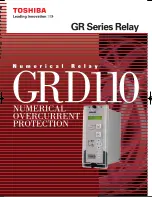
TB MRI(K)3-C 03.02 E
37
5.9
Fault Recorder (FR)
5.9.1 Fault Recorder
The existing store can be utilised in two ways:
Not to be overwritten
Previous recordings will not be overwritten. When there
is no memory space left, further recordings are not pos-
sible.
Overwrite
The latest fault incidents can always be called up; The
eldest recording is overwritten by a new one.
Parameter
Mode
Time per record (s)
Adjustment*
50 Hz
60 Hz
S=1
overwrite
8.00
6.66
S=2
Not to be over-
written
8.00
6.66
S=3
overwrite
4.00
3.33
S=4
Not to be over-
written
4.00
3.33
S=7
overwrite
2.00
1.66
S=8
Not to be over-
written
2.00
1.66
* s = total no. of recordings
Table 5.2:
The storage zone of the fault recorder is designed as
ring buffer. In the example shown below storage of 7
fault recordings are possible (overwriting). The 8
th
seg-
ment serves as buffer store.
Memory space 6 to 4 is used.
Memory space 5 is needed for temporary storage of
ongoing signals.
Abbildung 5.1: Partitioning of the store into 8 segments, for instance
This example shows that the store was used for more
than 8 recordings because store spaces 6, 7 and 8 are
used. From this it follows that no. 6 was the eldest re-
cording and no. 4 the latest one.
trigger occurence
recording duration
Tpre
[s]
Abbildung 5.2:
General Set-Up of the Fault Recorder
Each of the storage segments have a fixed storage time
where the time before the trigger event can be defined.
Via the RS485 interface the data can be read out by
means of a PC provided with HTL/PL-Soft4. The data is
graphically edited and represented. Binary tracks are
recorded additionally, e.g. activation and trip.
5.9.2 Number of fault recordings
The max. recording time is 16 s at 50 Hz or 13.33 s at
60 Hz.
The max. number of recordings to be stored has to be
defined beforehand. There is the choice between (1)*
2, (3)* 4 and (7)* 8 recordings. Hence the existing
memory space can be used as follows:
(1)* 2 recordings for 8 s at 50 Hz and 6.66 s at
60 Hz.
(3)* 4 recordings for 4 s at 50 Hz and 3.33 s at
60 Hz.
(7)* 8 recordings for 2 s at 50 Hz and 1.66 s at
60 Hz.
* will be overwritten when a new trigger signal occurs.
















































